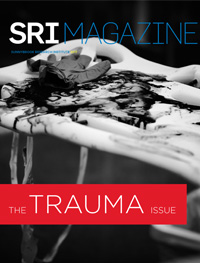Launched: first clinical trial of focused ultrasound for Alzheimer’s


Dr. Kullervo Hynynen (third from left), Dr. Nir Lipsman (centre-back), Dr. Sandra Black (far right) and the rest of the team in the MRI control room as they deliver low-intensity focused ultrasound to a patient, not seen here, during the world’s first clinical trial of this technology to open the blood-brain barrier in Alzheimer’s disease in May 2017.
Photo: Kevin Van Paassen
In May 2017, researchers and neurosurgeons at Sunnybrook made history when they became the first to use focused ultrasound technology to open the blood-brain barrier (BBB) in a person with Alzheimer’s disease. In a packed MRI control room in the heart of Sunnybrook Research Institute (SRI), they tracked the procedure on a monitor, sharing smiles when it was clear the procedure had worked. With the success, they knew this first step would be one for the archives and, they hoped, the history books as-yet unwritten.
In Canada, 564,000 people are thought to have Alzheimer’s disease. In the U.S., the number tops 5 million. Treatment options are lacking, and none stop progression. One medication after another has failed to show an effect in clinical trials. The thinking is that this might be down to the bouncer of the brain—the BBB—doing an effective job at barring entry of the study drugs. A layer of tightly packed cells, the BBB is important. It prevents toxic substances from infiltrating our most precious organ. The problem is, it blocks potentially beneficial substances, like 97% of medications.
Among the researchers overseeing the procedure was Dr. Kullervo Hynynen, director of Physical Sciences at SRI. He pioneered the technology in collaboration with industry. Also there was Dr. Nir Lipsman, a neurosurgeon and principal investigator of the trial and Dr. Sandra Black, director of the Hurvitz Brain Sciences Research Program and a co-principal investigator of the trial. The procedure works like this: the patient is fitted with a helmet-like device and positioned in an MRI scanner. Microbubbles, harmless bubbles of gas, are injected into the bloodstream, where they travel to the brain. Then, focused ultrasound is applied through the helmet at very low intensities to a precise area previously identified. This causes the bubbles to vibrate, which in turn prompts the BBB to open only at the small, targeted area. Contrast dye previously injected into the patient shows up on MRI and enables the researchers to monitor what happens in real time. During the study, they saw the BBB open precisely where they wanted it to open. Roughly eight hours later, the BBB closes, which the researchers verify the next day with a follow-up MRI scan.
The trial follows a painstaking process of technology development and lab experiments—two decades’ worth. Hynynen and Dr. Isabelle Aubert, a neuroscientist at SRI, were the first to show preclinically that focused ultrasound enables the delivery of anti-amyloid drugs, genes and stem cells into the brain safely and precisely. Moreover, they were also the first to show in mice that focused ultrasound alone, without any drugs, restores working memory and sparks the growth of new neurons.
The first stage of the trial—as is the case with all “first-in-human” studies—is evaluating safety and feasibility. No drugs are being used. Looking ahead, the researchers have a few plans in mind, depending on the outcome of this trial. These include targeting the hippocampus, a vaguely seahorse-shaped structure where we store and process memories. They also hope to start delivering small amounts of drugs. As exciting a development as this trial is, it is but a baby step. Much more research is needed. Nonetheless, it is the thought of those living with Alzheimer’s, and the millions of people who take care of them, that keeps the researchers’ eyes trained on taking all the baby steps needed until, well, one giant leap.



